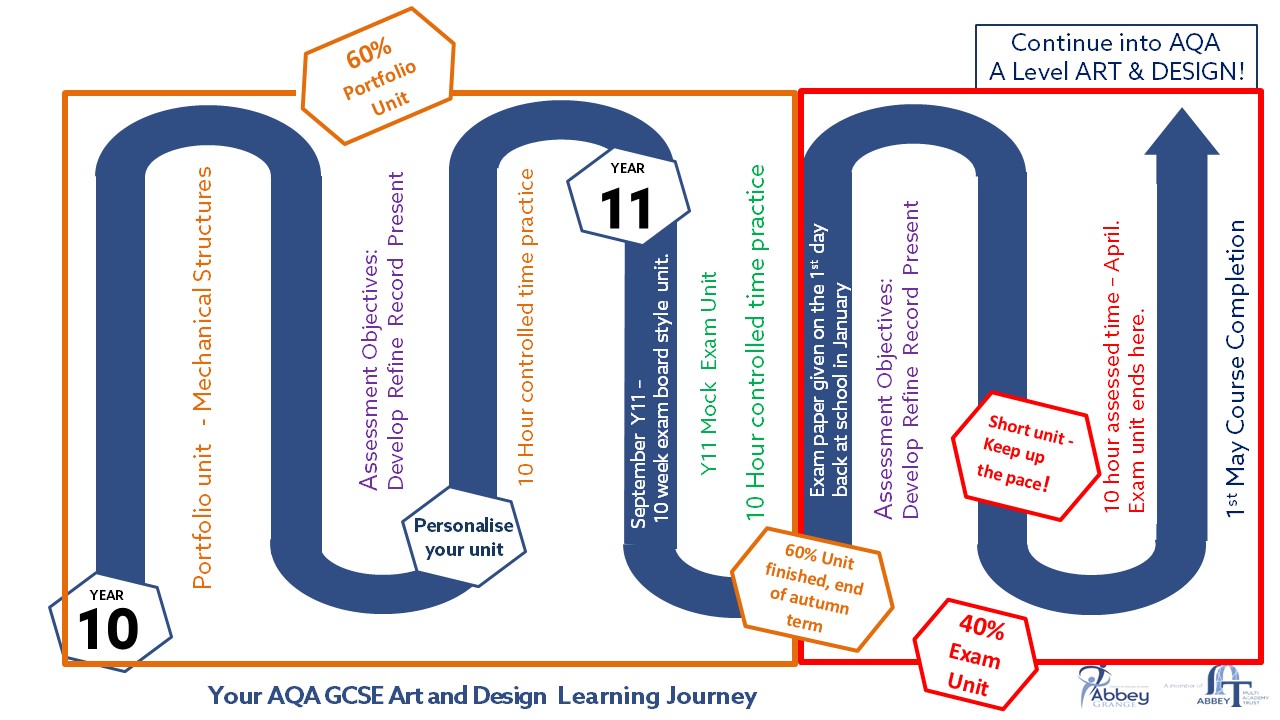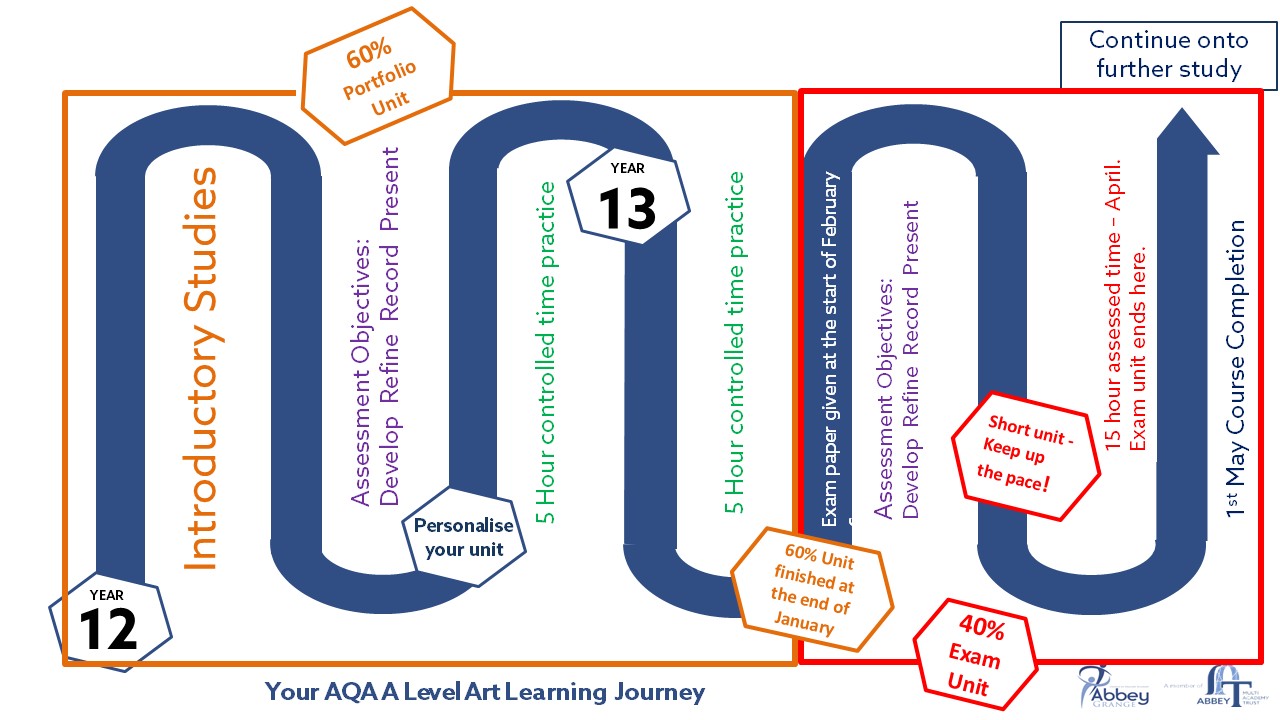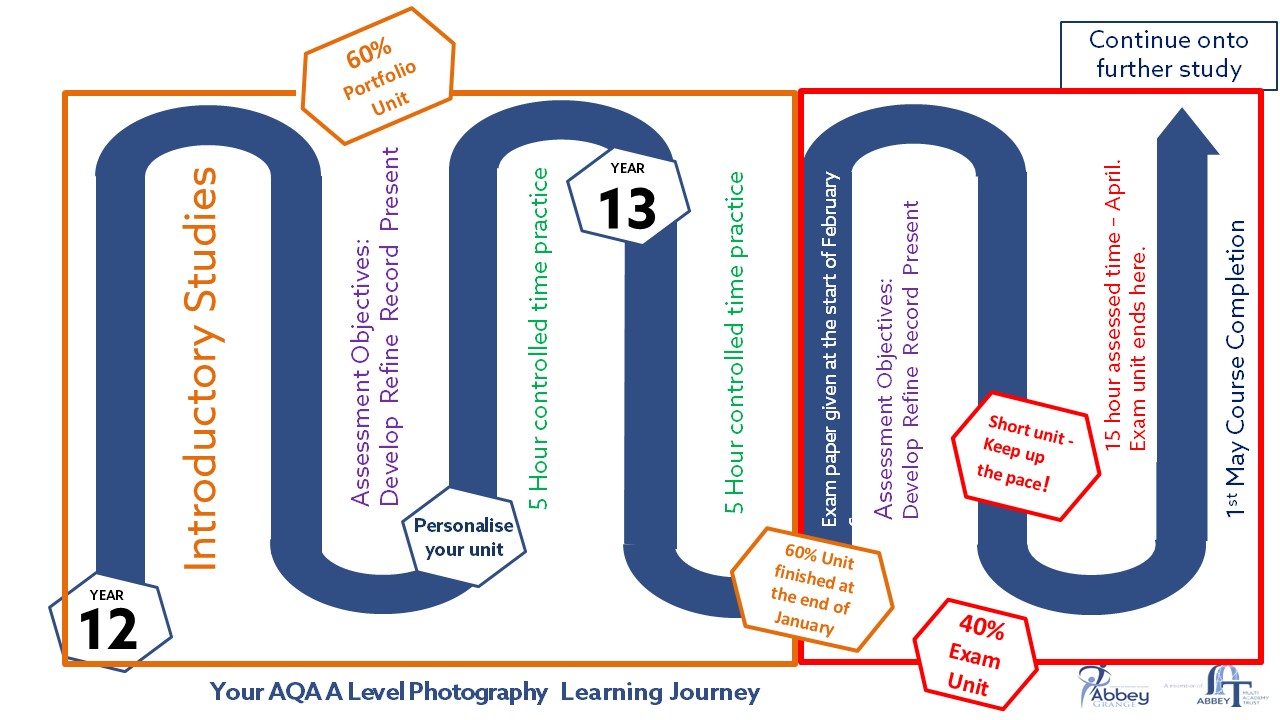
Through a thoughtfully sequenced and varied art curriculum, we aim to inspire our students to be ambitious and to appreciate diverse and inclusive art. Our students will leave Abbey Grange with a lifelong love of art and a curiosity in the visual world. Students will feel empowered to reflect on their everyday life and how they interpret the world around them through art.
An ability to draw, sculpt or create any form of visual artwork is to have an ability to speak a universal language. Draw a flower on a piece of paper and any person from any nation could understand what you have drawn.
The study of Art and Design fosters students’ natural creativity and curiosity of images whilst developing technical skill in a variety of materials and processes. Art and Design encourages students to explore the potential of materials and communicate their personal ideas.
We are now living in an incredibly visually rich world where Facebook, smartphones and plasma screen TV’s are a part of the fabric of everyday life. The study of Art and Design merely highlights how important the visual world is to us. In an age where even the most complex factual information is just a click away, subjects that promote students originality and creativity are important – well we think so! You can’t ‘Google’ how to come up with an original artistic idea.

Our KS3 curriculum is designed to build students confidence in handling a range of materials and processes whilst fostering their natural ability for creativity and experimentation. We include artwork, artists, art projects and issues that are relevant to the students in our classroom. Providing opportunities for reading, writing and discussion, enables students to think critically and creatively about art. Projects at KS3 centre around the key themes of: Formal Studies, Issues, Identity and Culture, Experimentation and Exploration.
As a school champion partner with ArtUK, Y7 and Y8 students learn through The Superpower of Looking®. This is an innovative and inclusive programme that seeks to transform the visual literacy skills of every child. We develop students’ essential superpower: the ability to really 'see' in an image-saturated world – to critically observe, analyse, question, interpret and empathise.
Following on from this inclusive practice for all learners; students are challenged to ‘speak like a specialist’ creating an audible oracy presentation about a piece of artwork that captures their imagination. Y7 focus on artworks, whilst Y8 reflect on Yorkshire as the sculpture capital of the UK. Abbey Grange was a leading school partner with Yorkshire Sculpture International 2019, hosting an ArtUK ‘Masterpiece in School’ – Eduard Paolozzi’s ‘AG5’. The department has strong links with local galleries and students are encouraged to visit Leeds Art Gallery, The Henry Moore Institute, The Hepworth in Wakefield or the Yorkshire Sculpture Park.
Y9 develop collaborative presentations in class through ARTiculation lessons. This strong foundation of oracy skills in KS3 leads pupils onto highly acclaimed success in Y10 and Y12 through the ARTiculation programme, opening a new window into the world of public speaking with leading arts professors and academics.
These transformative oracy projects allow the voice of students to be heard and exemplifies our Abbey Character vision of Aspiration and Excellence.
We value the rich and diverse global heritage of Abbey Grange students. Our students’ voice has been published in National Research through The Runnymede Trust and Freelands Foundation Visualise: Race and Inclusion in Art Education report 2024. The initiative aims to catalyse long-term structural change in a sector where, despite the success of individual artists such as Sonia Boyce, Lubaina Himid, Steve McQueen and Chris Ofili, only 2.7% of the workforce are from a Black, Asian or ethnically diverse background.
We are proud to work with National Art programmes such as ‘The World Reimagined’. It calls on us to courageously face our shared history with honesty, empathy and grace, so that we can create a new future in which all can say: I am seen. That is the mission of The World Reimagined.
Through the curriculum, pupils learn about a range of well-known and lesser-known artists, makers, and designers. These selections reflect the breadth of practice in art and the potential for future creative possibilities. Contextualising art and artworks historically and geographically allow pupils to recognise themselves in the visual world whilst broadening their perspectives.
As a close partner with Leeds Arts University, many of our students attend the After School Club and Easter and Summer Schools. These programmes provide considerable additional hours of extracurricular creative arts engagement to expand pupils’ creative skills and enhance their portfolio.
Students reflect on their own and others learning regularly through a mix of self, peer and teacher feedback. Students improve work lesson by lesson using ‘React’ targets.
Teacher assessment at the end of a project with a holistic grade on a scale between 1 – 70.
KS3 students can develop a deeper understanding of the connection between art and spirituality, and how art can be a powerful tool for expressing personal beliefs and exploring the world around them. Spirituality in art refers to how artists use their work to express deeper meanings, beliefs, and connections to something larger than themselves.
Common misconception
Critical thinking focuses on judging artworks as 'good' or 'bad'.
Critical thinking helps artists and audiences to think deeply about art and respect different viewpoints.
In Islam, the tradition is to not depict living creatures, that are associated with idols and statues. Abstract geometrical forms were favoured in mosques, based on mathematical shapes and forms, because they encourage spiritual contemplation.
For example, circles have no end-they are infinite- and so they remind Muslims that Allah is infinite. Complex geometric designs that decorate walls and ceilings create the impression of unending repetition, and this also helps a person get an idea of the infinite nature of Allah. The repeating patterns can represent that in the small details, you can find the infinite.
Challenging and Expanding Representation:
Wiley's art encourages viewers to consider the potential for beauty, resilience, and spirituality to emerge from even the most challenging circumstances.
The opportunity to work with increasing independence at KS4. The exam board awards the highest marks to those who show: ‘An exceptional ability to competently present a personal and meaningful response and realise intentions with confidence and conviction.’
Students, you are encouraged by teachers to explore making art that is interesting to you, with materials that you want to use, such as sculpture, painting, mixed media and digital pieces.

The specification has been designed to allow students to develop knowledge and understanding during the course through a variety of learning experiences and approaches, including engagement with sources. This will allow them to develop the skills to explore, create and communicate their own ideas.
Students will demonstrate these skills through the development, refinement, recording, realisation and presentation of their ideas through a portfolio and by responding to an externally set assignment.
Students are required to develop knowledge, understanding and skills relevant to their chosen title through integrated practical, critical and contextual study that encourages direct engagement with original works and practice.
Students may work in any medium or combination of media. They can work entirely in digital media or entirely non-digital media, or in a mixture of both, provided the aims and assessment objectives are met.
Students must learn through practical experience and demonstrate knowledge and understanding of sources that inform their creative intentions. Intentions should be realised through purposeful engagement with visual language, visual concepts, media, materials and the application of appropriate techniques and working methods.
Students must develop and apply relevant subject-specific skills in order to use visual language to communicate personal ideas, meanings and responses.
Students must, over time, reflect critically upon their creative journey and its effectiveness in relation to the realisation of personal intentions.
The following definitions of art, craft and design highlight the distinguishing characteristics of each domain. These domains can be addressed separately or in an integrated way depending upon the intentions and purposes of work undertaken.
More information can be found here:
AQA -GCSE Art and Design (Art, craft and design)
Click here to view our GCSE Art 'How to' Guide
We feel it is important to develop students’ skills of critical thinking and public speaking at an early age. We have won both national competitions twice in the past four years, proving our investment in this area is paying dividends.
The competition is for Key Stage 4 students and is closely linked to the National Gallery’s Articulation Prize for 16-19 year olds. Students submit a 2-3 minute film of themselves speaking about a piece of art, architecture or artefact of their choice. You can enter in pairs or as an individual. Judges from the University of Leeds and the National Gallery then view each film, looking at content, structure, delivery and the speaker’s original approach and unique potential. They will choose eight entrants to take part in our summer final on campus at the University of Leeds.
Students reflect on their own and others learning regularly through a mix of self, peer and teacher feedback.
Formative assessment – regular feedback on pieces of work by teachers with a focus on how to improve.
Final assessment takes place in Y11 during May. The portfolio and exam unit are assessed as individual units worth 60% and 40% respectively. The marking takes place under careful protocols in the school centre by teachers, pair marking each unit against the AQA assessment standards. Teachers attend AQA standardisation meetings annually as part to ensure consistent and fair marking of NEA (non-examined assessment) units. AQA moderators attend the school in person to view moderate the centre’s GCSE marking as part of the formal awards process. Grade boundaries are set nationally by AQA each year.
KS4 students can develop a deeper understanding of the connection between art and spirituality, and how art can be a powerful tool for expressing personal beliefs and exploring the world around them. Spirituality in art refers to how artists use their work to express deeper meanings, beliefs, and connections to something larger than themselves.
The study of Art links to many careers and skills needed for careers. These include but are not exclusive to:


A broad-based course exploring practical and critical/contextual work through a range of 2D and/or 3D processes.
Students must be introduced to a variety of experiences that explore a range of two-dimensional and/or three-dimensional media, processes and techniques. They should be made aware of both traditional and new media.
Students should explore the use of drawing for different purposes, using a variety of methods and media on a variety of scales. Students may use sketchbooks/workbooks/journals to underpin their work where appropriate.
Students should explore relevant images, artefacts and resources relating to a range of art, craft and design, from the past and from recent times, including European and non-European examples. This should be integral to the investigating and making processes. Students' responses to these examples must be shown through practical and critical activities that demonstrate their understanding of different styles, genres and traditions.
Students should be aware of the four assessment objectives to be demonstrated in the context of the content and skills presented. They should be aware of the importance of process as well as product.
Within each component, students must demonstrate evidence that they have explored critical and contextual work through a range of two-dimensional and/or three-dimensional processes and media.
Component 1: must show evidence of working in areas of study drawn from two or more of the endorsed titles listed below.
Component 2: must show evidence of areas of study drawn from one or more of the endorsed titles listed below.
The area(s) of study selected for Component 1 can be the same as, or different to, those selected for Component 2.
A-level Art and Design (Art, craft and design)
A-level Art and Design (Photography)
All students studying Art or Photography at KS5 will take part in ARTiculation with some students progressing on to the competition phase.
Students are invited to each deliver a 10-minute presentation to an audience about a work of art, architecture or an artefact of their choice. Adjudicators then assess each presentation as a whole, looking at content, structure, delivery and the speaker’s original approach and unique potential.
In the Speak for Change report (Oracy APPG 2021), 78% of young people stated that education should prioritise oracy, but only 32% found it actually did. Taking part in Articulation will improve:
Students reflect on their own and others learning regularly through a mix of self, peer and teacher feedback.
Formative assessment – regular feedback on pieces of work by teachers with a focus on how to improve.
Final assessment takes place in Y13 during May. The portfolio and exam unit are assessed as individual components worth 60% and 40% respectively. The marking takes place under careful protocols in the school centre by teachers, pair marking each component against the AQA assessment standards. Teachers attend AQA standardisation meetings annually as part to ensure consistent and fair marking of NEA (non-examined assessment) units. AQA moderators attend the school in person to view moderate the centre’s A level marking as part of the formal awards process. Grade boundaries are set nationally by AQA each year.
KS5 students can develop a deeper understanding of the connection between art and spirituality, and how art can be a powerful tool for expressing personal beliefs and exploring the world around them. Spirituality in art refers to how artists use their work to express deeper meanings, beliefs, and connections to something larger than themselves.
The study of Art links to many careers and skills needed for careers. These include but are not exclusive to: